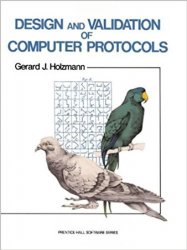Design And Validation Of Computer Protocols
- Добавил: daromir
- Дата: 22-01-2018, 16:51
- Комментариев: 0

Автор: Gerard J. Holzmann
Название: Design And Validation Of Computer Protocols
Издательство: Prentice Hall
Год: 1991
ISBN: 0135399254
Серия: Prentice Hall Software Series
Язык: English
Формат: pdf
Размер: 1,3 mb
Страниц: 512
Protocols are sets of rules that govern the interaction of concurrent processes in distributed systems. Protocol design is therefore closely related to a number of established fields, such as operating systems, computer networks, data transmission, and data communications. It is rarely singled out and studied as a discipline in its own right. Designing a logically consistent protocol that can be proven conect. however, is a challenging and often frustrating task. It can already be hard to convince ourselves of the validity of a sequentially executed program. In distributed systems we must reason about concurrently executed, interacting programs.
This text is intended as a guide to protocol design and analysis, rather than as a guide to standards and formats. It discusses design issues instead of applications.
The first part of the book covers the basics. Chapter 1 gives a flavor of the types of problems that are discussed. Chapter 2 deals with protocol structure and general design issues. Chapters 3 and 4 discuss the basics of error control and flow control.
The next four chapters cover formal protocol modeling and specification techniques, beginning in Chapters 5 and 6 with the introduction of the concept of a protocol validation model, that selves as an abstraction of a design and a prototype of its implementation. In Chapter 5 a terse new language called PROMELA is introduced for the description of protocol validation models, and in Chapter 6 it is extended for the specification of protocol correctness requirements, hi Chapter 7 we use PROMELA to discuss a number of standard design problems in the development of a sample file transfer protocol. Part II closes with a discussion, in Chapter 8. of the extended finite state machine, a basic notion in many formal modeling techniques.
The third part of the book focuses on protocol synthesis, testing, and validation techniques that can be used to battle a protocol's complexity. Both the capabilities and the limitations of the formal design techniques are covered.
The fourth and last part of the book gives a detailed description of the design of two protocol design tools based on PROMELA: an interpreter and an automated validator. Based on these tools, an implementation generator is simple to add. Source code for the tools is provided in Appendices D and E. The source is also available in electronic form. Ordering information can be found in Appendix E.
Внимание
Уважаемый посетитель, Вы зашли на сайт как незарегистрированный пользователь.
Мы рекомендуем Вам зарегистрироваться либо войти на сайт под своим именем.
Уважаемый посетитель, Вы зашли на сайт как незарегистрированный пользователь.
Мы рекомендуем Вам зарегистрироваться либо войти на сайт под своим именем.
Информация
Посетители, находящиеся в группе Гости, не могут оставлять комментарии к данной публикации.
Посетители, находящиеся в группе Гости, не могут оставлять комментарии к данной публикации.
